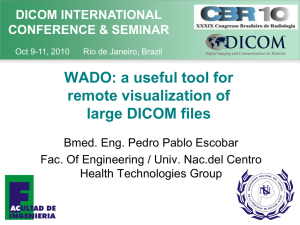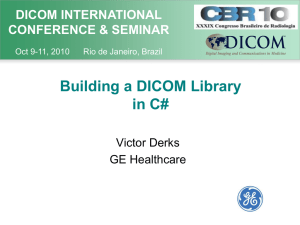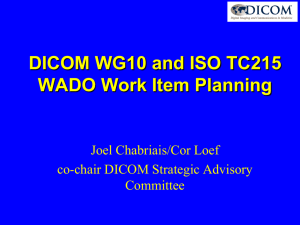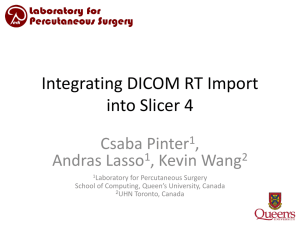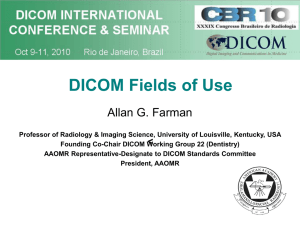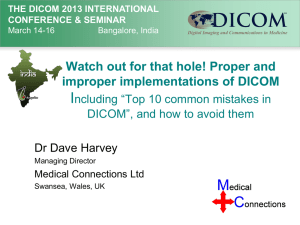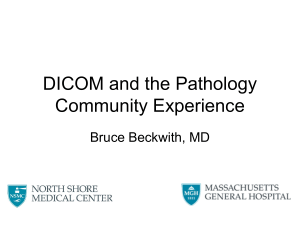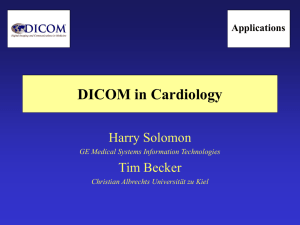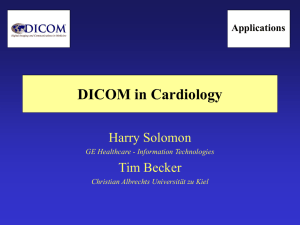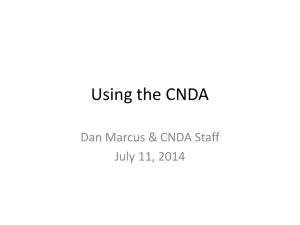map from acquisition data organization into volume representation
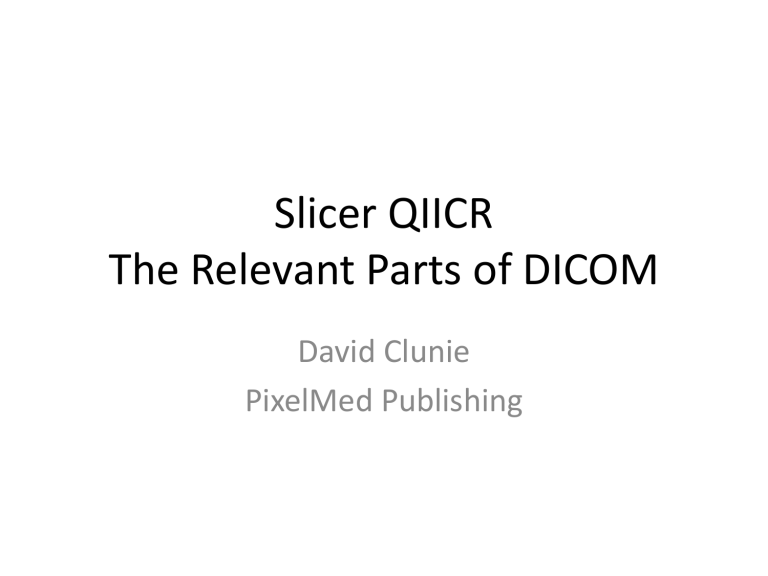
Slicer QIICR
The Relevant Parts of DICOM
David Clunie
PixelMed Publishing
DICOM needs for Specific Aims
• SA1: “Workflows and tools for analyzing longitudinal
imaging and derived data. Multiparametric prostate
MRI, PET/CT of head & neck cancers, and MRI of
microvascular properties of glioblastomas are projects in QIN that will be analyzed to define core requirements for functionality and internal organization. Custom analysis and data organization workflows will be designed within 3D Slicer for each
of the clinical projects.”
DICOM needs for Specific Aims
• SA2: “Standards-based structured reporting and representation of quantitative analysis results. The internal organization of the software developed in
SA1 will be analyzed and mapped into interoperable format according to the DICOM standard compatible
with commodity PACS technology. The developed functionality will be used to store and share the
results of analyses produced by the clinical projects.”
DICOM needs for Specific Aims
• SA3: “User- and developer-level interfaces to data
archives. Interoperability of data objects defined in
SA2 with locally installed and national data archives for cancer imaging research will be established. Userlevel interfaces will be created in 3D Slicer to interface data archives, such as The Cancer Image
Archive (TCIA).”
DICOM needs – why?
• Compatible with commodity PACS
• Store and share the results of analyses
• Interoperability of data objects
DICOM needs – what?
• Longitudinal imaging
• Derived data
• Multi-parametric data
• Micro-vascular properties (DCE-MR)
• Structured reporting
• Quantitative analysis results
DICOM versus NRRD etc.
• DICOM objects contain “composite context”
– Patient … same for all instances for patient
– Study … same for all instances for procedure
– Series … new for each derivation
– Equipment
– Frame of Reference
• Needs to be de-identified or access restricted
DICOM versus NRRD etc.
• DICOM objects contain “composite context”
– Patient … same for all instances for patient
– Study … same for all instances for procedure
– Series … new for each derivation
– Equipment
– Frame of Reference
• Needs to be de-identified or access restricted
• Slicer needs to preserve and propagate
– into derived objects (images, SEG, REG, SR etc.)
DICOM for Imaging in General
• Slicer supports import sets of slices
• “map from acquisition data organization into
volume representation” [Slicer wiki]
• Slicer cannot export back to DICOM
• Import supports only single-frame (legacy) rather than “enhanced multi-frame” DICOM
CT and MR objects
DICOM for Imaging in General
• Slicer supports import sets of slices
• “map from acquisition data organization into
volume representation” [Slicer wiki]
• Slicer cannot export back to DICOM
• Import supports only single-frame (legacy) rather than “enhanced multi-frame” DICOM
CT and MR objects
• Extend slicer to import DICOM Enh.MF
• Extend slicer to export DICOM SF and Enh.MF
Enhanced Multi-Frame
• More like NRRD (etc.) volume in one “file”
• All slices in single DICOM Instance
• “Vector” of attributes describing each frame
• Attributes grouped with similar siblings
– “functional groups”
• Itemized per-frame
– Per-Frame Functional Groups Sequence
– same order as encoded frames in Pixel Data
• Commonality factored out
– Shared Functional Groups Sequence
Multi-frame Functional Groups
Shared attributes
Per-frame attributes
Pixel data
Slicer & DICOM Import/Export
• Map geometry and acquisition timing
• Internal Slicer representation
• External DICOM SF and Enh.MF modes
• +/- DICOM Stacks (helpful, easy)
• +/- DICOM Dimensions (required for SEGs)
• Single 3D volume
• 4D volumes
• Round-trip fidelity if same Frame of Reference
Slicer & DICOM Import/Export
• Map geometry and acquisition timing
• Internal Slicer representation
• External DICOM SF and Enh.MF modes
• +/- DICOM Stacks (helpful, easy)
• +/- DICOM Dimensions (required for SEGs)
• Single 3D volume – definitely in Slicer
• 4D volumes – needed for perfusion (DCE-MR)
• Round-trip fidelity if same Frame of Reference
DICOM for Longitudinal Imaging
• Cross-procedure timing (year/month/day)
– within-procedure timing – contrast/radionuclide
• All existing DICOM image objects contain
– dates & times (study/series/acquisition/content)
– reference to local or explicit time zone
• Possibility of named/ordinal time points
– Clinical Trials Modules (optional) (composite ctx.)
– esp. Clinical Trial Time Point
– or could manage “out of band” (store elsewhere)
DICOM for Longitudinal Imaging
• Cross-procedure timing (year/month/day)
– within-procedure timing – contrast/radionuclide
• All existing DICOM image objects contain
– dates & times (study/series/acquisition/content)
– reference to local or explicit time zone
• Possibility of named/ordinal time points
– Clinical Trials Modules (optional) (composite ctx.)
– esp. Clinical Trial Time Point – add to Slicer
– or could manage “out of band” (store elsewhere)
DICOM for Derived Data
• Derived data that is image or image like
• Pixel (voxel) rather than ROI-based calculation
• Intermediate calculations on images
• “Parametric maps”
• e.g., DCE-MR Ktrans, PET SUVbw, CT RCBV
• Each pixel (voxel) has real world meaning
– continuous value, dimensionless, physical units
• Representation – float or scaled integer?
DICOM for Parametric Maps
• Which IOD (SOP Class)?
– same as original modality (CT, MR)
– secondary capture
– something new ? private, extend standard
– can be multi-frame rather than single frame
– give user a choice (based on their tools)
• What encoding?
– scaled integers – everybody supports
– floating point – not yet standard; but can work
• Easy to make
– if geometry & composite context available to propagate
DICOM for Parametric Maps
• Which IOD (SOP Class)?
– same as original modality (CT, MR)
– secondary capture
– something new ? private, extend standard
– can be multi-frame rather than single frame
– give user a choice (based on their tools)
• What encoding? Slicer should support both
– scaled integers – everybody supports
– floating point – not yet standard; but can work
• Easy to make
– if geometry & composite context available to propagate
DICOM for Label Maps
• Which IOD (SOP Class)?
– Image
– Segmentation
• What encoding?
– Image
• PALETTE COLOR (each pixel is index into RGB LUTs)
• no semantics for value
– Segmentation
• each frame is a “segment” (one label)
• each pixel (voxel) can be binary or occupancy fraction/probability
• segment is described with coded property category/type/anatomy
DICOM for Label Maps
• Which IOD (SOP Class)?
– Image
– Segmentation
• What encoding?
– Image – Slicer could support
• PALETTE COLOR (each pixel is index into RGB LUTs)
• no semantics for value – could extend standard to add properties
– Segmentation – Slicer should definitely support
• each frame is a “segment” (one label)
• each pixel (voxel) can be binary or occupancy fraction/probability
• segment is described with coded property category/type/anatomy
Segmentation Possibilities
• Simple encoding of single ROI (segment) on one or more spatial slices (e.g., 3D tumor)
• Different tissue types in one lesion (e.g., necrotic part, solid part, enhancing part)
• Multiple lesions in one object, each a separate segment
• An entire classification of tissues in a volume
(e.g., brain atlas)
Segmentation Possibilities
• Simple encoding of single ROI (segment) on one or more spatial slices (e.g., 3D tumor)
• Different tissue types in one lesion (e.g., necrotic part, solid part, enhancing part)
• Multiple lesions in one object, each a separate segment
• An entire classification of tissues in a volume
(e.g., brain atlas)
• Slicer should support all that it can create
Harvard SPL Brain Atlas
• Took NRRD files
– converted LUT indices to codes
– for each slice of LUT indices, made a binary frame of each index
• Resulting SEG object
– 315 segments, 6463 frames
• Not a very efficient representation
– sparse, so compresses very well (zip 71:1)
– sacrificing space allows overlapping segments
Harvard SPL Brain Atlas
DICOM for Quantitative Results
• Parametric maps are one quantitative result
• Need to encode Regions of Interest (ROIs)
• Applied to original images & parametric maps
• Where is the ROI?
– contours or segments
– 2D (image-referenced) or 3D (frame of reference)
• What is (are) the resulting calculations(s)?
– type, value, units
DICOM Encoding of ROIs
• Private elements (evil & must be stopped)
• Curves in image (weak semantics, old, retired)
• Overlays in image (weak semantics)
• Presentation States (weak semantics, PACS favorite)
• Structured Reports (best choice, more work)
• RT Structure Sets (coordinates only)
• Segmentations (per-voxel ROIs; use with SR)
DICOM Encoding of ROIs
• Private elements – Not relevant to Slicer
• Curves in image – Not relevant to Slicer
• Overlays in image – ?? Slicer Export
• Presentation States – ?? Slicer Export since
PACS favorite
• Structured Reports – Slicer Import/Export
• RT Structure Sets – Slicer Import/Export
• Segmentations – Slicer Import/Export
DICOM Structured Reports
• Hierarchical structure
– codes, numbers, coordinates, image references, etc.
• Flexibility is constrained by templates
– just as XML is constrained by DTD or Schema
• Standard DICOM binary representation
– easily stored in PACS though visualization remains challenging
– easily transcoded to XML for processing
• Widely used in existing quantitative modalities
– echo-cardiography, obstetric ultrasound
SR – Questions & Answers
• Basic structure is name-value pair
– name is the “question” (code)
– value is the “answer” (text, code, numeric, etc.)
• Different style choices possible, e.g.
– (M-54000,SRT,“Necrosis”) = (G-A203,SRT,“Present”)
– (F-00005,SRT,“Finding”) = (M-54000,SRT,“Necrosis”)
• Template of questions & value sets
– populated by human (pick lists from value sets)
– encode image processing results (e.g., detect signal)
– rule based (e.g., too small to measure)
DICOM SR – details inside
DICOM SR – as visualized
Date Volume Auto LD Auto SD
20021207 27080 49 27
… … … …
Ref. to SEG
DICOM RT Structure Sets
• Simple structure
– focus: iso-contour 3D coordinates regions to treat/spare
– very limited semantics
– no standard/extensible measurements, just volume
• Standard DICOM binary representation
– easily transcoded to other DICOM objects like SR or PS if
3D (patient-relative) to 2D (image-relative) coordinate mapping is available (e.g., via source images or an SR image library)
• Widely used in existing RT & non-RT workstations
– also understood by many academic software tools
DICOM Presentation States
• Intended to preserve appearance
– grayscale pipeline (window)
– spatial transformation (pan/zoom)
– annotation (text, overlays, vector graphics)
• Lack semantics
– what does text “mean”?
– which graphic is it associated with?
• Overall, a poor choice for quantitation
– may be all that is available in many PACS (to create/view)
Show Your Work
• Save/restore state +/- undo/repeat
• Intermediate images
– floating point, propagation of composite context
• Description of steps
– codes in SR templates
• Are other common artifacts that aren’t images
– Registration objects (REG)
– Real World Value Maps (RWVM)
– Fiducials
– Surfaces (Surface SEG)
DICOM Registration & Fiducials
• Mapping between 3D coordinates
– DICOM Registration – rigid matrix
– DICOM Deformable Registration
• Location of specific points
– DICOM Fiducial
• Used to save manual or automated results
– save application state for further work later
– re-use for other purposes (e.g., sync’d scrolling)
DICOM Real World Value Maps
• Separate pipelines based on pixels
– what to show on the display
– what the pixel (voxel) “means”
• e.g., MR pixel values
– signal intensity windowed for display
– mapped to physical unit (e.g. velocity for phase contrast)
• DICOM implementation
– within image or separate object (e.g., derived later)
– linear equation or LUT, applied to all or sub-set of range
– point operation (all voxels) (unlike US Region Calibration)
Real World Value Maps
Modality
LUT
VOI
LUT
P
LUT
Display
Stored
Values Real world
Real
Value
LUT
Real World
Value LUT
Data
(0040,9212) or
Real World
Value Intercept and Slope attributes value
Value Unit
Measurement
Units Code
Sequence
(0040,08EA)
Current
DICOM
Images from
Modality
Previous
DICOM
Images from
PACS
Putting it all together …
Previous
DICOM SR etc
Analysis
Workstation
DICOM
Segmentation
DICOM
Registration
DICOM SR
DICOM Real
World Value
DICOM
Parametric Map
Images
PACS Store,
Distribute and Review
Lessons from Commercial Example
• Siemens syngo.Via MultiModality Oncology
• REG, RWVM (PET SUV calculation), SEG
• SR with measurements, co-ords & references
• Encoding changes as concept of template & standard support is improved (3D coords)
• Bugs … bit order in SEG for table removal
• Need to support old “versions” of templates
• Avowed goal is save/restore state only
Toolkit support
• DICOM network (send/receive/query/retrieve)
• DICOM parsing (nested lists of attribute)
• DICOM <-> XML conversion
• Extraction of “models” (classes?) of content
– image extraction (8/16/32 bit, gray or RGB)
• compression/decompression (codecs)
– structured report “content tree”
– enhanced multi-frame concepts (esp. SEG)
• geometry – spacing, orientation, position
• dimensions, stacks, timing
• Coded content (SNOMED, LOINC, RadLex, FMA)
Gaps in DICOM Standard
• Floating point pixel data
– existing objects scaled integers only
– do have OF and OD data types
– use with “private” objects
– PixelData (7FE0,0010) with OF or OD
• works, but problem with big/little endian conversions
– new “Floating” PixelData (7FE0, ????)
• a bit more work for all toolkits, but probably safer
– need convincing (low risk) “use case” for committee acceptance
Selected Tools
• Slicer, CTK, dcmtk
• dcmtk – good SR, XML support, no enhanced multiframe or geometry abstractions, excellent network, compression, security support
• CTK –widgets using (most recent ?) dcmtk ??
• Slicer – dcmtk and ITK geometry handling (need gap analysis re. multi-frame geometry translations)
• ? handling of abstractions like extracting 3D/4D/nD volume data set from mixed series, etc. (“frameset”
“partitioning” problem)
Archival Aspects – Legacy Images
• Well supported in existing open image archives (OAIs) (or generic OTS/COTS DICOM archives/VNAs)
• Ingestion – file import, C-STORE SCP, web submit (+/- deidentification)
• Indexing – parse DICOM “header” and extract patient(subject)/study/series/image values
• Query – search using extracted header values – C-FIND SCP, web page, web services (SOAP or RESTful)
• Retrieve – C-MOVE (C-GET less common), web page
(immediate or shopping cart), web services (SOAP or RESTful)
Archival Aspects – Other Objects
• More recent image objects
– enhanced CT/MR – ?? Indexing/query limitations
• SEGs, RWVMs, REGs, SRs
– indexed like images – retrievable (esp. whole study)
– no specific query support
– no “structured querying of analysis results”
– Is XML conversion a panacea? (separate database)
– need appropriate XML form
– sufficiently clear coded concepts
– search by code or search by string, for anatomy, finding, segmented property type, etc.
Segmentation Object
• Just an Enhanced Multi-frame “image”
– Functional Groups and Dimensions
• Each frame is (part of) a segment
• One slice in space/time
– each pixel (voxel) is either binary (in segment or not) or fractional occupancy/probability
– bits packed into bytes or words
• Multiple segments, each numbered
• Frames described with “vector” of characteristics
– segment #, position, orientation … order irrelevant
Segmentation Object
• Can overlap
– e.g., one voxel in space may be in multiple segments
– cw. “label map” style encoding with each pixel an index of
(one choice) of segment
• May be 1:1 with voxels of source image (wasteful)
– or just (3D) bounding box around segmented voxels
– may also be sampled differently, down-sampled or upsampled in-plane or between slices
• May explicitly reference source images
– or be generalized in 3D space (frame of reference UID)
– recipient has to choose which image series
Enhanced Multi-Frame
• More like NRRD (etc.) volume in one “file”
• All slices in single DICOM Instance
• “Vector” of attributes describing each frame
• Attributes grouped with similar siblings
– “functional groups”
• Itemized per-frame
– Per-Frame Functional Groups Sequence
– same order as encoded frames in Pixel Data
• Commonality factored out
– Shared Functional Groups Sequence
Multi-frame Functional Groups
Shared attributes
Per-frame attributes
Pixel data
Enhanced Multi-frame
• Single slice
– top level dataset
• Image Position (Patient)
• Image Orientation (Patient)
– Pixel Spacing
• Multi-frame
– Shared Functional Group Sequence (1 item)
• Pixel Measures Sequence > Pixel Spacing
• Plane Orientation Sequence > Image Orientation (Patient)
– Per-Frame Functional Group Sequence (n items)
• Plane Position Sequence > Image Position (Patient)
Enhanced Multi-frame
• Single slice
– top level dataset
• Image Position (Patient)
• Image Orientation (Patient)
• Pixel Spacing
• Multi-frame
– Shared Functional Group Sequence (1 item)
• Pixel Measures Sequence > Pixel Spacing
• Plane Orientation Sequence > Image Orientation (Patient)
– Per-Frame Functional Group Sequence (n items)
• Plane Position Sequence > Image Position (Patient)
• Frame Content Sequence > Stack ID and In-Stack Position
Dimensions
Start with a dimension of space.
A set of contiguous slices through the heart.
Stack ID = 1
2
1
In-Stack Position
3
4
5
Space
Trigger
Delay
Time
Temporal
Position
Index
48 ms 2
0 ms 1
Stack ID = 1
2
1
In-Stack Position
3
4
5
Stack ID = 1
Add dimension of time (delay time from R-wave).
Sets of contiguous slices throughout cardiac cycle.
Time
2
1
In-Stack Position
3
4
5
Space
Trigger
Delay
Time
Temporal
Position
Index
48 ms 2
0 ms 1
Stack ID = 1
2
1
In-Stack Position
3
4
5
Stack ID = 1
1 \ 5 \ 2
Dimension
Index
Values
Dimension Index Pointers:
1.
Stack ID
2.
In-Stack Position
3.
Temporal Position Index
Time (2)
2
1
In-Stack Position
3
4
5
Space (1)
Trigger
Delay
Time
Temporal
Position
Index
48 ms 2
0 ms 1
Stack ID = 1
1 \ 5 \ 2
Dimension
Index
Values
2
1
In-Stack Position
3
4
5 1\5\2
1\4\2
1\3\2
1\2\2
1\1\2
Stack ID = 1
Dimension Index Pointers:
1.
Stack ID
2.
In-Stack Position
3.
Temporal Position Index
Time (2)
2
1
In-Stack Position
3
4
5 1\5\1
1\4\1
1\3\1
1\2\1
1\1\1
Space (1)
Trigger
Delay
Time
Temporal
Position
Index
48 ms 2
0 ms 1
Stack ID = 1
2 \ 1 \ 5
Dimension
Index
Values
2
1
In-Stack Position
3
4
5 2\1\5
2\1\4
2\1\3
2\1\2
2\1\1
Stack ID = 1
Dimension Index Pointers:
1.
Temporal Position Index
2.
Stack ID
3.
In-Stack Position
Time (1)
2
1
In-Stack Position
3
4
5 1\1\5
1\1\4
1\1\3
1\1\2
1\1\1
Space (2)
Trigger
Delay
Time
Temporal
Position
Index
48 ms 2
0 ms 1
Stack ID = 1
2 \ 1 \ 5
Dimension
Index
Values
2
1
In-Stack Position
3
4
5 2\1\5
2\1\4
2\1\3
2\1\2
2\1\1
Stack ID = 1
Dimension Index Pointers:
1.
Trigger Delay Time
2.
Stack ID
3.
In-Stack Position
Time (1)
2
1
In-Stack Position
3
4
5 1\1\5
1\1\4
1\1\3
1\1\2
1\1\1
Space (2)
Trigger
Delay
Time
Temporal
Position
Index
48 ms 2
0 ms 1
2 \ 5
Dimension
Index
Values
5
4
3
2
1
Index of Image Position (Patient)
2\1
2\2
2\3
2\4
2\5
Dimension Index Pointers:
1.
Trigger Delay Time
2.
Image Position (Patient)
Time (1)
5
4
3
2
1
Index of Image Position (Patient)
1\1
1\2
1\3
1\4
1\5
Space (2)
